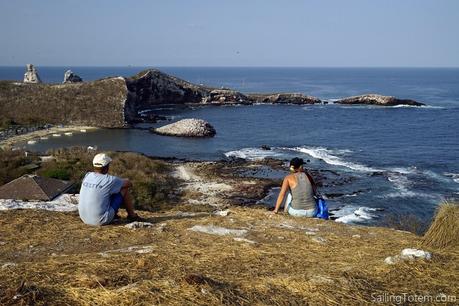
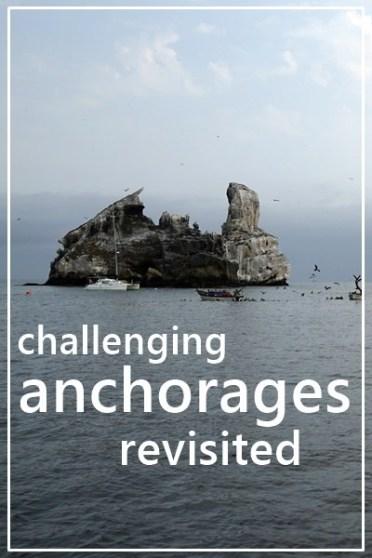
Isla Isabel’s roadstead
Rising from a hazy marine layer, from a distance this island resembled the craggy rock of our memory: a place that might be called barren if it weren’t for the tens of thousands of frigates and boobies (and iguanas and more) that call it home. “Barren” is how we’d hoped to see the anchorage there – well, except for the Island Spirit catamaran called Love & Luck with kid-loaded crew.
We’d anchored at Isabel three times previously, all in 2009. Our first came with the added stress of a sunset arrival and pods of whales. I know, pods of whales – it sounds cool, but it’s can be nerve-racking to navigate when multiple groups are swimming in indeterminate directions and are a lot bigger than your boat.
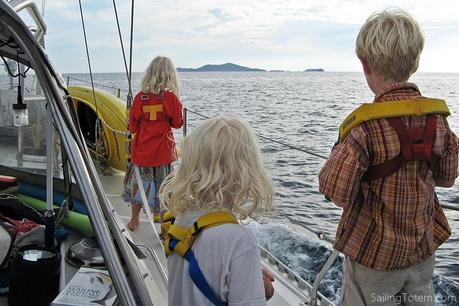
Arriving at Isla Isabel, January 2009
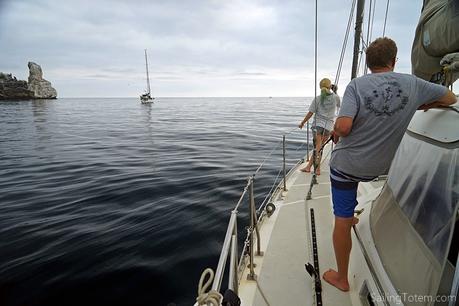
Mairen on the bow, 10+ years later at Isla Isabel again
Isabel’s more protected anchorage on the east side of the island is a tricky spot with only a narrow ledge for anchoring with relatively thin sand over rock: only a few boats can fit. It’s the kind of place where you show up not knowing if conditions will allow you stay: Totem’s log entry for Isla Isabel from January 2009 records anchoring in 40’, with “rock ledge, boulders / small sand patch, good weather only.”
This time, there was a crowd waiting. Only the catamaran’s freeboard was visible from a distance, but eight fishing boats came into view as the island loomed larger. Mostly open boats, 25-30’ long, the vessels appeared to be in exactly the area we recalled was the limited range for anchoring at a reasonable depth. Great. Active fishing in progress did not increase our options.
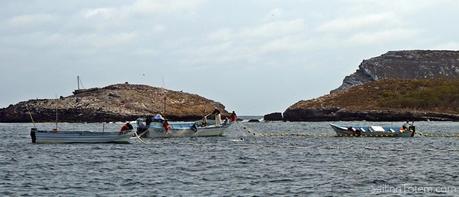
Ten years ago, that might have given us enough pause to keep sailing: no room, oh well, carry on! Cruising guides say you have to anchor in closer so it must be true. But with hundreds of anchorages chalked up to experience, our definition of reasonable depth had changed while our confidence in setting the anchor has grown. Instead of being near shore in 40’, we found a spot in 70’ and safely spaced from the other boats. Ten years ago, I’m not sure we’d have tried this, and it was actually a much better spot! Bonus: besides having plenty of room, the bottom there was flat sand and offered excellent holding and no rocks to snag on! We put out about 320’, a scope of around 4.3 to 1, and enjoyed four nights anchored off this mini-Galapagos.
Isla Isabel’s animal kingdom of ground-nesting boobies and arboreal frigatebirds are fearless, as are the green iguanas that roam both; it’s a special opportunity to visit such a natural wonderland. Watching ostrich-like fuzzy frigate chicks, seeing the reunion of booby pairs when a mate returns to the nest, their turquoise feet providing almost comical relief to the reverent dance.
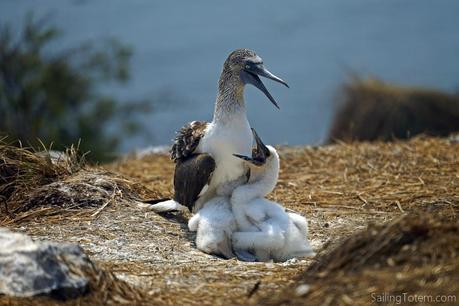
Bring a zoom lens to get pictures from a distance without unnerving birds
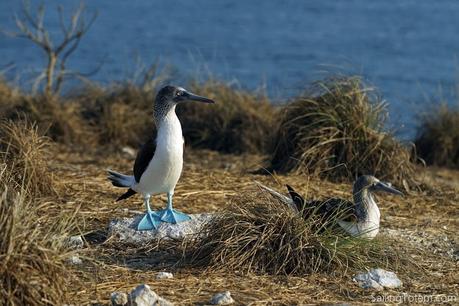
The color of their blue-footed boobies really does defy belief
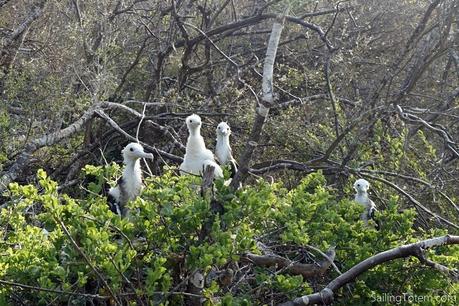
Are you my mother? Frigate chicks peer out from shoulder-height nests
La Paz’s Mogote
Totem swings on the hook off La Paz in southern Baja. This anchorage is known as the El Mogote, named for the antler-shaped spit that’s on the other side of the bay. It’s also famous for the La Paz waltz.
Anchoring here the first time in December 2008, we learned all about the intricacies of this waltz quickly enough. Current rips down the channel from the Sea of Cortez to this historic town and capital for the state of Baja California Sur. The flow of water often opposes wind direction; the result is that the location of a boat relative to the location of its anchor is highly variable, and may create uncomfortably close neighbors. Swirls mean it’s not uncommon to see boats pointing in literally every cardinal direction, and not because they’re bobbing on a windless afternoon but from opposing forces levering against varying hull profiles.
Complicating matters: things happen relatively quickly. In our first two hours at anchor, we traveled nearly two miles in 180 foot wide arc.
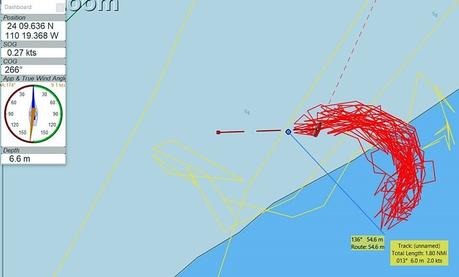
Anchoring can have the unfortunate side effect of making people judgmental, and the Mogote brings that out: it’s extraordinarily difficult to pick a spot here. Often a crowded anchorage, it’s particularly difficult to set the hook when you can’t look at a boat and intuit where the anchor lies. Any given boat’s scope is unpredictable, even if you know where they’re sitting relative to their anchor. The snubber and chain may offer a suggestion, but ground tackle could literally be behind the boat. A poorly marked (well, not really marked) shoal runs most of the length of the anchorage: avoiding it, then picking a side and keeping a swing circle clear is not straightforward. The occasional long-term denizen’s claim to needing swing room rings of turf protection and doesn’t always come off well.
When we anchored here in early days, the lack of certainty sometimes meant staying on board at times we’d like to have gone ashore. Even now we play that choice cautiously; despite feeling good about our set, there’s unpredictability in how boats will move, neighbors and Totem alike. One of the newer cruisers here, still building experience anchoring, nudged on the sandbar early in his stay. Decision: pick up a slip in the marina. There’s no shame in that at all, just some coin. Building experience in easier anchorages will make this one less intimidating.
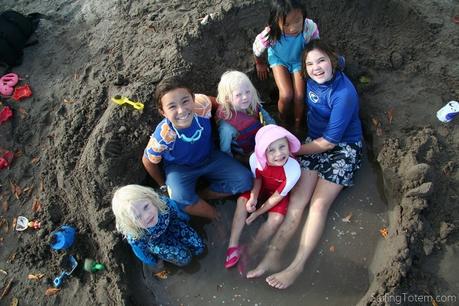
2009: water pits in the Mogote (kid crews from Totem, Bay Wolf, Eyoni, and Third Day)
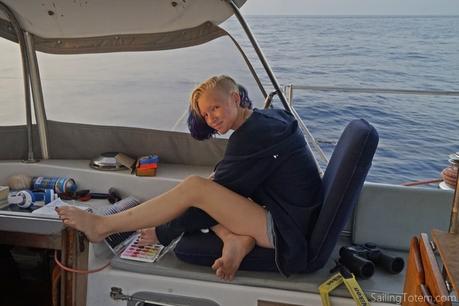
2019: water colors in the cockpit.
La Paz is a convenient stop off, with great food choices, and one we keep brief to wind our way to prettier islands and more solitary anchorages. For one reason or another, we’ve re-anchored Totem three—no, four times in about as many days, but each time was low-stress. Neighbor getting too close? Not confident in proximity to possible mooring/fishing float? Swinging a little close to the channel? My favorite, being asked to move by two painfully polite Navy crew, trying hard not to bang their tender into Totem while 3 knots of current flooded by, asking us to clear the way for their ship — it needed more room for departure. No problem. Making the call is easier now. Executing once the decision is made is, too.
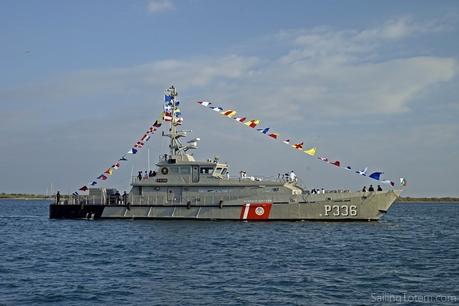
Less convenient: the morning we planned to depart, a swarm of bees in need of a hive had taken up temporary residence at the base of Totem’s mast, tucked into a halyard coil. Disconcerting at first, their tightly clustered activity became more fascinating. The entirely docile bees weren’t a problem at all, other than a possible complication of departure plans, and choosing Totem a kind of blessing.
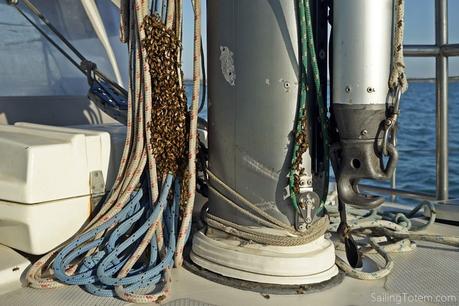
Bees swarm by the base of the mast
I tried to find a beekeeper to migrate them to a new hive. Jamie had some other ideas. “Utopia,” of course, isn’t just an alternate state for the bees but the name of our friends’ Beneteau anchored at right.
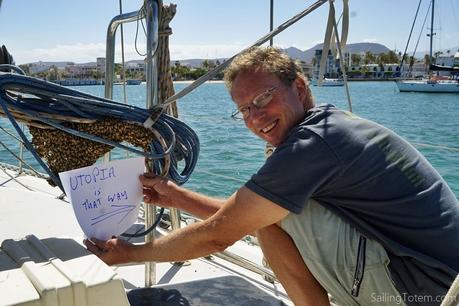
They left without further urging while we were on shore, not taking the cue (friend Aileen pointed out they may not have been spelling bees); a near-complete disappearance that was almost disappointing. Hopefully they’re ensconced in a better place now! I never did connect with a beekeeper in town, but learned of options if it happens again.
On our way north to the islands shortly; follow along via our PredictWind tracking page. It was the challenges posed by these two anchorages stuck with us over time, but it’s the beauty of those ahead we anticipate. Here’s a little more from Isla Isabel, meanwhile.
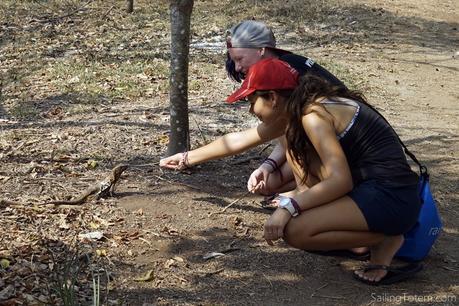
Siobhan and Ava tickle a curious iguana under the chin
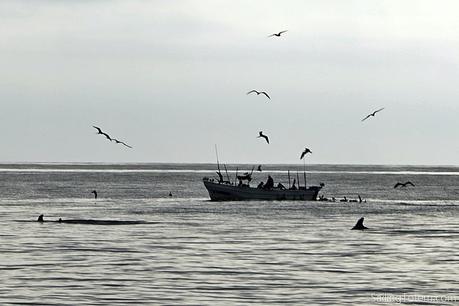
Frigates look for fish scraps while false killer whales circled first the anchorage, and then the island one morning

Boat teens rule!

